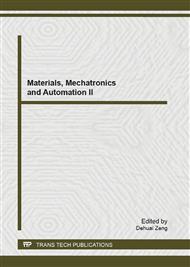[1]
W. J. Van der Linden, and C.A.W. Glas: Computerized Adaptive Testing: Theory and Practice. (Boston, MA: Kluwer 2000).
Google Scholar
[2]
L. A. Zadeh: Information and Control Vol. 8 (1965) pp.338-353.
Google Scholar
[3]
Y. H. Lin, and J. M. Yih: Applied Mechanics and Materials, Vol. 55-57 (2011) pp.2197-2201.
Google Scholar
[4]
T. J. H. M. Eggen, and G. J. J. M. Straetmans: Educational and Psychological Measurement Vol. 60 (2000) pp.713-734.
Google Scholar
[5]
N. A. Thompson, and D. J. Weiss: Practical Assessment, Research & Evaluation Vol. 16 (2011) pp.1-9.
Google Scholar
[6]
H. Zimmermann: Fuzzy Set Theory and Its Applications ( Boston: Kluwer Academic Publishers 2001)
Google Scholar
[7]
G. J. Klir, and B. Yuan: Fuzzy Sets and Fuzzy Logic: Theory and Applications (Upper Saddle River, NJ: Prentice Hall 1995)
DOI: 10.1021/ci950144a
Google Scholar
[8]
J. Y. Halpern: Reasoning about Uncertainty (Cambridge, Mass: MIT Press 2003).
Google Scholar
[9]
Y. H.. Chang, and B. M. Ayyub: Fuzzy Sets and Systems Vol. 119 (2001) p.187–203.
Google Scholar
[10]
M. M. Nasrabadi, E. Nasrabadi, and A. R. Nasrabady: Applied Mathematics and Computation Vol. 163 (2005) p.245–251
DOI: 10.1016/j.amc.2004.02.008
Google Scholar
[11]
H. Tanaka, I. Hayashi, and J. Watada: European Journal of Operational Research Vol. 40 (1989) pp.389-396.
Google Scholar
[12]
M. S. Yang, and T. S. Lin: Fuzzy Sets and Systems Vol. 126 (2002) p.389–399.
Google Scholar
[13]
W. Näther: Computational Statistics & Data Analysis Vol. 51 (2006) p.235–252.
Google Scholar
[14]
P. Lin, B. L. Wu, and J. Watada: International Journal of Innovative Computing, Information and Control, Vol.8 (2012) pp.7437-7450.
Google Scholar
[15]
J. Kacprzyk, and M. Fedrizzi: Fuzzy regression analysis (Warsaw: Springer-Verlag 1992)
Google Scholar
[16]
H. Tanaka, S. Uejima, and K. Asai: IEEE Syst., Man, Cybern., SMC-12 (1982) pp.903-907.
Google Scholar
[17]
B. L. Wu, and N. F. Cheng: Journal of the Chinese Statistical Association Vol. 36 (1998) pp.399-420.
Google Scholar


